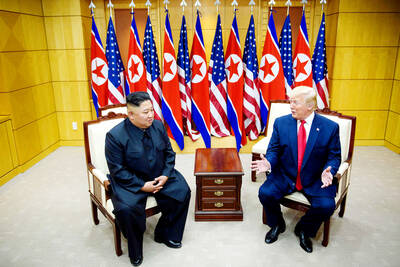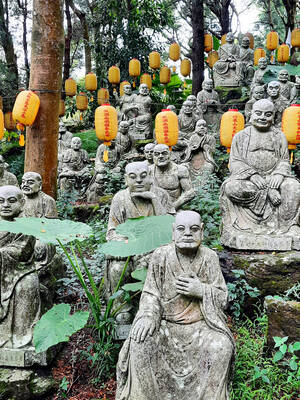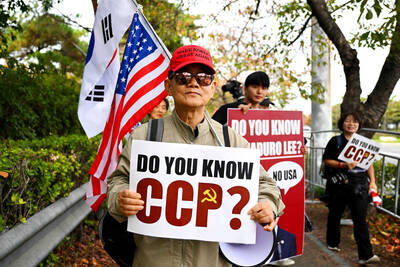The Ever Green Vegetarian Restaurant (長春素食) offers hotel-quality dining that’s relatively inexpensive and guilt-free — that is, unless you overeat. The restaurant, located near the intersection of Xinsheng North Road (新生北路) and Changchun Road (長春路), has an excellent all-you-can-eat buffet with dinner priced at NT$560 per person.
It’s a good deal, considering the well-prepared food and the surroundings. The enormous dining room, which seats more than 400 people, falls between a hotel conference room and traditional wedding banquet hall in terms of decor. Diners sit on soft plush chairs, perfect for enjoying the buffet at a leisurely pace and then leaning back when you’re stuffed.
The restaurant calls its spread a “European-style buffet,” which refers to the presentation and open kitchen where chefs prepare made-to-order stir-fry dishes, noodle soups and hot pot.
Most of the food consists of vegetarian versions of standard Chinese and Japanese dishes, along with a fresh salad bar of organic vegetables. Like many Buddhist vegetarian restaurants, Ever Green doesn’t cook with onion or garlic, but there are plenty of flavors to be found.
One memorable dish on a recent visit was a Sichuan-style mushroom stir-fry, which had a nice smoky flavor from the hollowed-out red chili peppers. The buffet also offers a few comfort food indulgences — there was an unusual but deliciously rich deep-fried taro ball stuffed with a dollop of curry sauce (have more than one at your peril), and fried battered mushrooms meant to emulate the night market staple yansuji (鹽酥雞), or fried chicken with basil.
Ever Green embraces the idea that being a vegetarian doesn’t mean you can’t pretend to enjoy consuming meat. Diners will also find a chilled “sashimi” bar stocked with fake salmon, tuna and yellowtail made out of konjac (蒟蒻), a plant-based gelatin. The look and texture came surprisingly close: The fake salmon was even dyed with white fat lines and tasted pretty good, especially with a dab of wasabi. But it won’t have sashimi lovers giving up the real thing anytime soon.
With the exception of the curried fried rice, which was cold and bland, it was hard to find anything unlikable. All of the vegetables, whether stir-fried or from the salad bar, tasted fresh and crisp.
Finish off the meal with a slice of marble cheesecake or Black Forest cake — just several among a dizzying array of desserts — and choose from a selection of herbal teas and juices.
As far as buffets go, Ever Green is worth visiting with a large appetite and time to spare.

US President Donald Trump may have hoped for an impromptu talk with his old friend Kim Jong-un during a recent trip to Asia, but analysts say the increasingly emboldened North Korean despot had few good reasons to join the photo-op. Trump sent repeated overtures to Kim during his barnstorming tour of Asia, saying he was “100 percent” open to a meeting and even bucking decades of US policy by conceding that North Korea was “sort of a nuclear power.” But Pyongyang kept mum on the invitation, instead firing off missiles and sending its foreign minister to Russia and Belarus, with whom it

When Taiwan was battered by storms this summer, the only crumb of comfort I could take was knowing that some advice I’d drafted several weeks earlier had been correct. Regarding the Southern Cross-Island Highway (南橫公路), a spectacular high-elevation route connecting Taiwan’s southwest with the country’s southeast, I’d written: “The precarious existence of this road cannot be overstated; those hoping to drive or ride all the way across should have a backup plan.” As this article was going to press, the middle section of the highway, between Meishankou (梅山口) in Kaohsiung and Siangyang (向陽) in Taitung County, was still closed to outsiders

President William Lai (賴清德) has championed Taiwan as an “AI Island” — an artificial intelligence (AI) hub powering the global tech economy. But without major shifts in talent, funding and strategic direction, this vision risks becoming a static fortress: indispensable, yet immobile and vulnerable. It’s time to reframe Taiwan’s ambition. Time to move from a resource-rich AI island to an AI Armada. Why change metaphors? Because choosing the right metaphor shapes both understanding and strategy. The “AI Island” frames our national ambition as a static fortress that, while valuable, is still vulnerable and reactive. Shifting our metaphor to an “AI Armada”

The Chinese Communist Party (CCP) has a dystopian, radical and dangerous conception of itself. Few are aware of this very fundamental difference between how they view power and how the rest of the world does. Even those of us who have lived in China sometimes fall back into the trap of viewing it through the lens of the power relationships common throughout the rest of the world, instead of understanding the CCP as it conceives of itself. Broadly speaking, the concepts of the people, race, culture, civilization, nation, government and religion are separate, though often overlapping and intertwined. A government